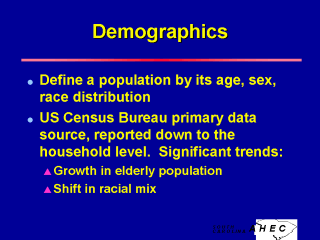| front |1 |2 |3 |4 |5 |6 |7 |8 |9 |10 |11 |12 |13 |14 |15 |16 |17 |18 |19 |20 |21 |22 |23 |24 |25 |26 |27 |28 |29 |30 |31 |32 |33 |34 |35 |36 |37 |38 |review |
 |
The aging of the
“Baby Boomers” born at the end of the second World War, the improved treatments for
disease, and healthier lifestyles have extended the life span of Americans. Currently, 13%
of the population is over age 65, but that is expected to increase to 20% by 2030. This
trend should continue well into the new millennium, and has serious implications for the
health needs and the demands on health resources in the future. By 2025 the 85+ population
is expected to double its current size. The shifting of the racial mix of the United States is due to the increasing number of immigrants seeking to become permanent residents and the birth rates among these groups. By 2000, 30% of the US population will be foreign born. The most significant change will be in the minorities groups. It is estimated that by 2020, the largest minority group will be Hispanics, replacing African Americans which have historically composed the largest group of minorities. Within 100 years, 50% of all Americans will be Black, Hispanic, or Asian in origin. This has implications for businesses, social support systems, and health. US Census: Current Population reports - Population projections of the United States by Age, Sex, Race, and Hispanic Origin: 1995 to 2050. |